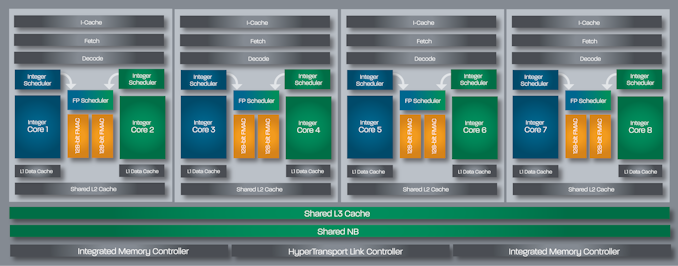AMD Bulldozer 'Core' Lawsuit: AMD Settles for $12.1m, Payouts for Some
by Anton Shilov on August 28, 2019 1:15 PM EST
AMD this month has agreed to pay compensation that totals $12.1 million to users who purchased FX-8000/9000 CPUs via its website or in the state of California. The case comes down to AMD advertising these processors as having 8 cores, and the claim that a shared FPU unit within a 'dual core' module does not constitute an actual core of performance similar to a separate core/FPU unit. Users who qualify for the compensation are estimated to recieve in the region on $35, depending on the exact uptake, and no one person can claim more than $7500.
AMD’s Bulldozer microarchitecture used 'dual-core modules' containing two independent ALUs and a shared FPU. AMD believed that such design allowed it to call its FX-8000 and FX-9000 series processors as the industry’s first eight-core desktop CPUs, yet the latter were quite often behind their quad-core rivals from Intel in terms of performance. As a result, a group of people from California filed a class action suit that accused AMD of false advertising back in 2015.
In early 2019, the Northern District Court of California sided with the plaintiffs and ruled that AMD’s FX-8120, FX-8150, FX-8320, FX-8350, FX-8370, FX-9370, and FX-9590 processors were incorrectly advertised as having eight cores. On August 23, the court published the class action settlement agreement under which AMD agreed to pay plaintiffs and the settlement class a compensation.
Under the terms of the deal, AMD has to create a $12.1 million settlement fund that will cover compensations to the end users, attorney fees, and settlement administration fees. The Class Counsel agreed to limit its petition for attorneys’ fees and reimbursement of expenses to no more than 30% of the fund, or $3.630 million, whereas the costs of settlement administration will be between $350,000 and $700,000. As a result, the pot to share between the actual purchasers of AMD’s select FX processors will be between $7.77 million and $8.12 million.
Purchasers entitled for up to $7500 total, have a confirmed purchase(s), and to have purched one of the processors while living in California or from AMD's website. It is noteworthy that people who bought AMD’s FX-8000E series CPUs with reduced power consumption are not eligible to get a reimbursement, and neither are people who purchased AMD’s six-core and quad-core FX-6000 and FX-4000 products.
It is hard to estimate how much money will each owner of AMD’s FX-8120, FX-8150, FX-8320, FX-8350, FX-8370, FX-9370, and FX-9590 processors will get, but considering the fact the settlement is limited to select CPUs and residents of California and those from AMD.com, actual sums may be quite sizeable. Should the actual value per unit be over $300, this will be subject to court approval.
AMD and the Settlement Administrator are order to crease a website at www.AMDCPUSettlement.com that should include the ability to file claim forms online. At press time, the website was offline, but it should be up shortly. We are awaiting AMD's official press release on the matter.
Update:
AMD has given an official comment on the result:
"AMD is pleased to have reached a settlement of this lawsuit. While we believe the allegations are without merit, we also believe that eliminating the distraction and settling the litigation is in our best interest."
Related Reading
- AMD's Steamroller Detailed: 3rd Generation Bulldozer Core
- The Bulldozer Review: AMD FX-8150 Tested
- The Bulldozer Aftermath: Delving Even Deeper
Sources: PACER, The Register (click through for document filing)











81 Comments
View All Comments
plewis00 - Thursday, August 29, 2019 - link
There was a lawsuit the other day against zero alcohol beer because it’s actually 0.1% or something like that and some Muslim woman was getting bent out of shape because her husband had violated religious code. It’s just the way you’re allowed to advertise things. I’m sure it doesn’t bother the majority. This cores thing was a big deal to people who potentially didn’t know better.Oxford Guy - Thursday, August 29, 2019 - link
I hope they don't consume citrus, because it has methanol in it. They may be violating their superstition by consuming anything with pectin in it, too:"Methanol is also formed when fruits and vegetables are physically prepared for consumption by slicing, chopping, pureeing and juicing. The production of free methanol in all these instances is the result of reactions in pectin, a principal component of plant cell walls and the middle lamella between them. Pectin is heteropolysaccharide contained in the primary cell walls of terrestrial plants. It is produced commercially as a white to light brown powder, mainly extracted from citrus fruits, and is used in food as a gelling agent particularly in jams and jellies. It is also used in fillings, medicines, sweets, as a stabilizer in fruit juices and milk drinks, and as a source of dietary fiber. Pectin will break down to methanol when the plant cell walls and middle lamellae are disrupted, as can happen through physical processes of food preparation. Methanol is also produced when pectin is digested after eating fruits and vegetables."
Religious insanity should not be indulged, in any form. It's a fundamental attack on efficiency, which means it drags everyone down.
Samus - Friday, August 30, 2019 - link
lmfao for real? so what are they going to call it now, light beer?ohh. yeah that...
Rickyxds - Wednesday, August 28, 2019 - link
Like I always saidbuldozer is eight (cores halves)
In math language is 8 * (1/2) = 4 cores
And the performance never lied
RedGreenBlue - Wednesday, August 28, 2019 - link
Integer performance was always 8 cores, and mixed performance between FP and integer was much better than 4 cores. Only in a straight FP environment could you argue the performance was the same as 4 cores. Even then there’s the variable of what size the floating point unit was, AMD could have done a 2x256 FP unit instead of 2x128. What then? This is why integer cores are widely accepted as the least common denominator of the term “core” when everything else fluctuates.RedGreenBlue - Wednesday, August 28, 2019 - link
*4x128 FP unit instead of 2x128Chaser - Wednesday, August 28, 2019 - link
I can remember back then when the buyers were boasting about their "8-core" CPUs. LOLplewis00 - Thursday, August 29, 2019 - link
Yes but if you speak out or joke about it, apparently you’re stupid and pro-Intel... that’s the general reaction.Oxford Guy - Thursday, August 29, 2019 - link
Fact is that code that is reasonably optimized for the Piledriver architecture and inherently compatible with its philosophy can perform more than adequately on it.For example, the game Deserts of Kharak showed excellent performance parity with 8 core Piledriver CPUs.
This comes despite the fact that AMD, being a much weaker company, in large part thanks to Intel's dirty tricks that robbed it of much-needed profit that would have gone to better R&D, released these parts with significant flaws. Those flaws would have been less likely to have appeared had AMD been financially stronger at the time. And, it wouldn't have just let Piledriver rot for so many years.
KAlmquist - Wednesday, August 28, 2019 - link
Here are some scaling numbers for Cinebench R10, calculated by dividing the multithread score by the single thread score:12023/3560 = 3.38 (FX-4130, 2 modules, 4 cores, 3.8 Ghz)
13242/3675 = 3.60 (Phenom II X4 955, 4 cores, 3.2 Ghz)
19179/5423 = 3.53 (Core i5 2400, 4 cores, 3.1Ghz, Sandy Bridge)
15060/4512 = 3.34 (Core i5 760, 4 cores, 2.8 Ghz, Nehalem)
Cinebench uses floating point, so the shared floating point unit comes into play here. The speedup seen on the 4 core Bulldozer is a bit on the low side, but not by a lot. On all four processors there are shared resources which prevent a perfect 4.0 speedup from being achieved.
For anyone who still thinks the module design can be compared to hyperthreading, here are some numbers for processors with hyperthreading:
11046/5095 = 2.17 (Core i3 2100, 2 cores, 4 threads, 3.1 Ghz, Sandy Bridge)
24933/6397 = 3.90 (Core I7 2600K, 4 cores, 8 threads, 3.4 Ghz, Sandy Bridge)
16598/4490 = 3.70 (Core i7 860, 4 cores, 8 threads, 2.8 Ghz, Nehalem)
Hyperthreading allows a little more performance to be extracted from each core, but nothing close to what you would get from actual cores.
You may have noticed that Bulldozer has the worst single-thread performance of any processor listed in this comment. It gets crushed by Sandy Bridge, which was released about three months before Bulldozer, but it's not even really competitive with Intel's Nehalem design. It can't even match AMD's own earlier offering, the Phenom II. <em>That</em> the problem with Bulldozer; it's not that you don't get the number of cores advertised; it's that they are <em>slow</em> cores.
If you bought an FX-4130 on the assumption that it would be the same speed as an i5 2400 because they both have four cores, you would be severely disappointed. But that's not because AMD misrepresented the number of cores. It's because you can't predict performance based solely on the number of cores; you also have to know how fast the cores are. The premise of the lawsuit is bogus.